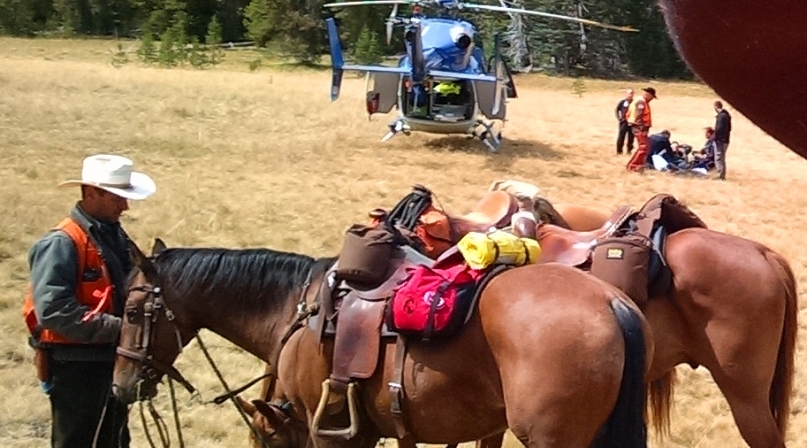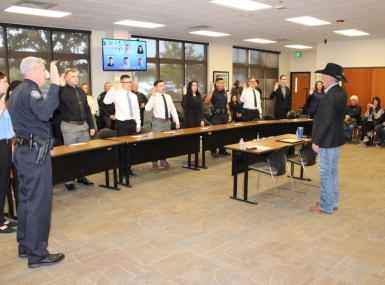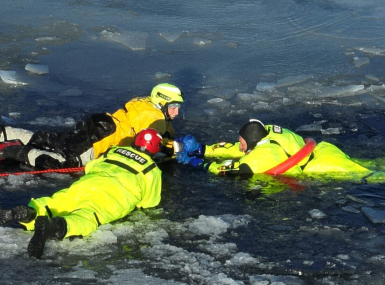Sheriffs’ posses alive and well in counties

A member of the Lane County, Ore. posse tends to the horses after rescuing a hunter lost in the woods. They took him on horseback to a clearing where a helicopter could transport him to a hospital in Eugene. Photo by Alan MurphyPosses give sheriffs a force of on-call volunteers
The math didn’t add up for Wes Thurston.
Six full-time deputies. Five part-timers. Himself — the sheriff of Clearfield County, Pa. His chief deputy. Three cars. Divide that by 1,145 square miles, the third largest county in Pennsylvania, and he knew he was outmatched.
But after a man suffering from dementia left a nursing home and was found dead more than 10 days later two miles away, Thurston woke up in the middle of the night and had his answer.
“I knew I had to start a posse,” he said. “We’re in a really rural area, we have miles and miles of forest. If I need 300 people to comb the area for a child who wandered away from a picnic table, I want to have those people in 45 minutes.”
He’s recruiting 500 volunteers, all of whom will be subject to background checks, but they won’t have arrest powers or the authorization to use force. He reports more than 300 applicants since announcing the plan in late December.
“It’s not just a bunch of hillbillies out there, we have doctors, lawyers, teachers…people with master’s degrees applying,” he said, noting that several women have expressed interest. “A chiropractor who has friends who do snowmobiling in the winter has volunteered their service. That’s something we wouldn’t have had on our own.”
The idea isn’t as quaint as it would seem. Less a vestige of cowboy movies and more a solution to large territories and small law enforcement staffs, there are more than 100 sheriff’s posses scattered around the country, most of them operating in Colorado, Oregon, Utah and California.
Liability policies for posse members vary by county.
In Geary County, Kan., Sgt. Thad Jones saw an underused sheriff’s reserves unit and wanted to scrap it in exchange for a posse program like what he was used to in Maricopa County, Ariz., where he worked previously.
“They’ll basically do the same things as deputies, except for having the power of arrest and they aren’t armed,” he said. “Ours will be able drive our cars, but without the flashing lights.”
The Geary County program is also in its nascent stages — just five months old, but it has 17 volunteers so far.
“They’ll basically be our third arm,” Jones said. “If we need an extra body, watching our back at a scene, they’ll be it. They won’t be helping investigate or making decisions.
“It’s great for people who want to help, people who want to be involved but not actually be a cop,” Jones said.
Thurston sees it as an opportunity to screen the people the sheriff may need for help someday, whether that is doing search and rescue, traffic control or other tasks that would free up his deputies to do investigative work.
“If I went out in the street and called for help, who knows who I’d get,” he said. “Drug dealers, drunks, people who are in over their heads… I’m looking for people I can depend on, people we’ve trained and can rely on to do the right thing. They’ll be safe and not get themselves into trouble in the process.”
While noting that circumstances in individual counties merit different approaches, John Thompson, deputy executive director of the National Sheriffs’ Association agreed with that prospect.
“To not pre-plan and have some kind of contingency in case something happens is very sad and I don’t think it’s in the best interest of the county,” he said. “I think they’re a good resource, to have it when it’s needed because human resources is our biggest problem.”
Being part of a posse is a civic activity for many participants. Jim Haney, president of the Columbia County, Pa. posse and a former police officer, was recruited to the posse by his friends and brother-in-law.
“We did a pretty good job patrolling the Bloomsburg Fair Grounds parking lot on horseback,” he said. “We had a good vantage point to see down between the cars and make sure people weren’t drinking or vandalizing cars.”
Haney has been involved in several search and rescue operations, including locating a downed airplane. The Columbia County posse is frequently called out to search for lost hunters.
In Lane County, Ore., posse member Alan Murphy was called upon for a search mission that eventually became a rescue mission when they learned the missing hunter who had been out for two days was in need of medication. A team of three carried the man on horseback to a clearing where a helicopter could pick him up and take him to the hospital.
Murphy has been a member of the posse for 10 years, and sees an operation like this every three years or so.
“I like horses,” he said. “I’m retired and I have time and wanted to do something useful with my horse so I joined the posse.”
That’s where Thompson sees a posses’ ideal place.
“Especially in rural areas, you need all the bodies you can get,” he said. “People who can stand at a traffic post and do the minor jobs that free the deputies to do their more serious jobs. If you have a standoff and all of your deputies are tied up there, that means there’s nobody left for the ordinary citizens.”
Thurston plans to break the posse up into five portions of the county, with roughly 100 members in each, and grouping them in teams of 10, coordinated by group leaders. He will give instructions in writing to each group, and any posse member who deviates from those instructions will be removed by the group leader.
“Another thing I see of value in the posse is that with such a large county, people from one end don’t know the people from the other end,” he said. “When we bring people together for training and organizational purposes, it’s going to bring a lot of cohesiveness. These men and women are all in it together.”
Attachments
Related News

CMS requires state Medicaid suspension upon arrest versus termination
Effective January 1, 2026, federal law now requires states to suspend, rather than terminate, Medicaid coverage when an individual is incarcerated.

ICE hiring surge challenges county law enforcement
Local governments hope that their law enforcement personnel will favor the familiarity of the communities they serve when weighing potentially lucrative immigration enforcement recruitment bonuses, which may require them to uproot their lives.

County officials moonlight in search and rescue roles
For some county officials, participating in search and rescue operations is another way to serve their communities, and make it safer for people to enjoy natural recreation resources.
